A comprehensive Magento vs Shopify guide every merchant should read before launching or migrating a website.
If you are planning to launch an online business and are considering which ecommerce platform to choose, our comparison of Magento 2 vs Shopify will help you do the right thing.
In 2022, Gartner published the Magic Quadrant for Digital Commerce report and again named Magento 2, a part of the Adobe ecosystem, a “Leader” among the digital commerce platforms. An extensive feature set, growing global partner network, and robust capabilities were critical factors that granted Magento 2 this title.
In the same report, Shopify was listed as a “Challenger” because of its usability, popularity among midsize brands, and large app store with hundreds of easy-to-install solutions. Below you can see how Adobe and Shopify are positioned on Gartner’s coordinate system with other major ecommerce platforms.
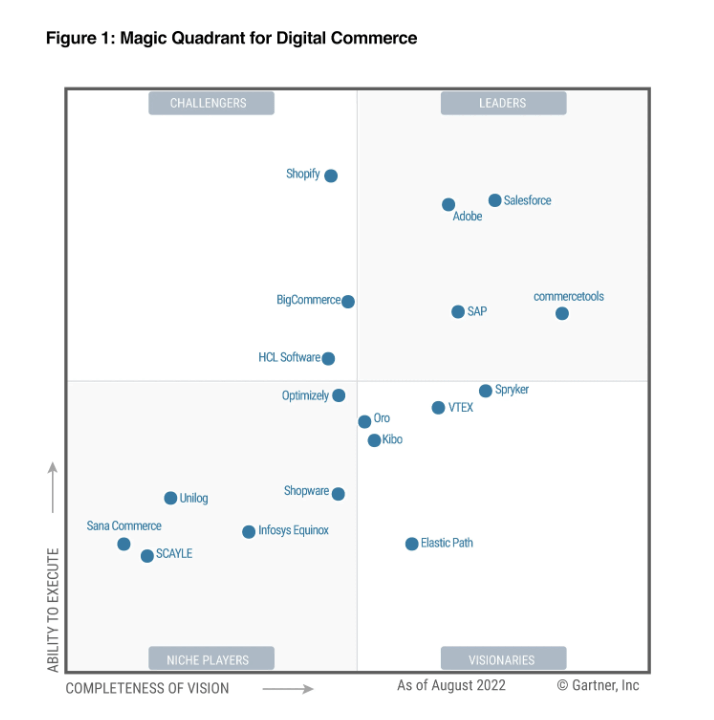
Now we are ready to dive deep into Magento and Shopify specifics and give you a full understanding of which platform will work best for your online business. Let’s start the ball rolling!
Magento vs Shopify: General Overview
Magento Overview
Market share. According to SimilarTech, around 90,000 websites are developed on Magento.
Geography. Magento is prevalent in the west, especially in the USA, while European countries, such as Great Britain and Germany, are not behind and actively use Magento. Here are the top countries with the most significant number of Magento-powered websites:
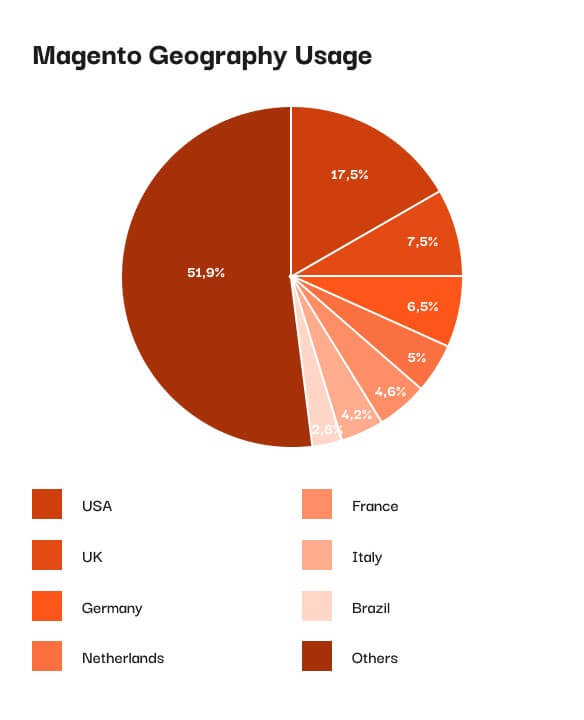
Top industries. Lifestyle, home & garden, ecommerce & shopping, computer electronics & technologies are common industries that choose to trust Magento.

Top Brands. Among leading brands powered by Magento are Coca-Cola, Samsung, Seat, Helly Hansen, Everlast, Land Rover, Ford, Omega, Fred Perry, Liverpool Store, etc.
Shopify Overview
Market share. Shopify is a choice for more than 600,000 websites, according to SimilarTech.
Geography. The platform is generally popular in the US, UK, and Canada and also gaining traction in Australia, India, Germany, and France.
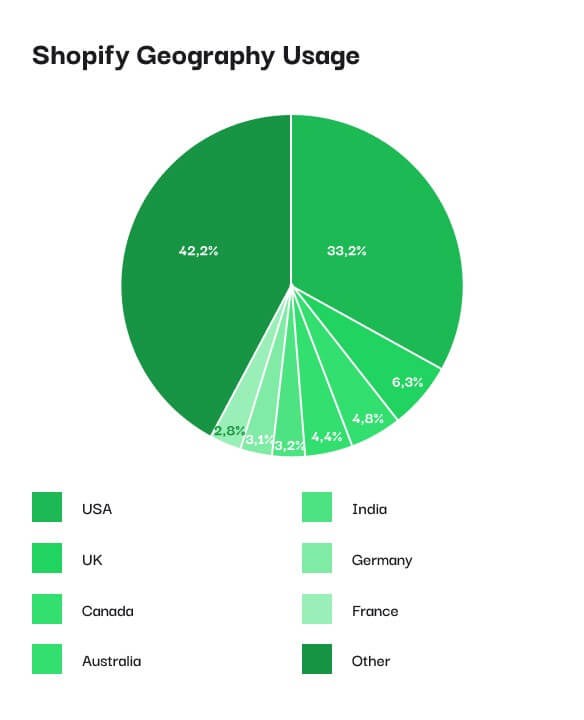
Top industries. The pie chart of industries represented on Shopify includes lifestyle, computer electronics & technologies, food & drinks, and sport.

Brands. Global brands, such as Beardbrand, Gymshark, ColorPop, Decathlon, FashionNova, Steve Madden, Spigen, and others, choose Shopify.
Shopify vs Magento: Behind the Scenes
Magento has two editions: Magento Open Source (Community) and Adobe Commerce (Enterprise) — the latter is an enterprise solution for large businesses.
Magento 2 Open Source is a free platform with open-source code that can be easily customized if you have a technical background or a trusted development team.
It is self-hosted, which means you’ll have to find your own hosting, configure it, download and install the Magento 2 instance, buy a domain name, and an SSL certificate on your own.
If you’re looking for the right hosting right now, Crazy Egg published their research on the best web hosting services. Frankly speaking, we loved it!
They chose 8 options, which are all compatible with Magento, purchased hosting plans, and built sites by hand on everyone. Then they used uptime and site speed tools to get real data on how good they really are. They also asked support teams the same 3 questions every time, then compared their response time and helpfulness.
The spoiler with the best option, in their opinion, is at the very beginning of the article 🙂
This legwork will pay off with full control of all aspects of your online store and the ease of its customization and scalability. The Magento 2 platform allows you to build anything — from a modest online store to an ecommerce empire, though you’ll need to invest in some customization.
Adobe Commerce, still called by many developers Magento Commerce, is a paid advanced version of Magento Open Source. It has a rich feature set and is suitable for businesses that want to grow. Adobe Commerce offers an omnichannel solution, supports B2C and B2B companies, is powered by AI, and backs you up with round-the-clock customer support.
Magento Pricing
Prices for extensions, themes, and license for Magento vary. It depends on your business needs how much you are going to pay. So, below you can find some pricing options you have with Magento.
Extension prices: start at $0 and can do up to $15,000 (however, the most common extensions cost around $80-$120).
Theme prices: $0-$460
License prices: $0 for Magento Open Source
Transaction fees: $0
Shopify Pricing
Unlike Magento, Shopify has a full subscription business model with different pricing plans and features. Prices start at €1 for a basic subscription and go up to €289 for an advanced plan. Sure thing, paying €1 is an attractive option, allowing you to discover if this platform is up to your expectations. However, a basic plan does not offer functionality for a standalone online store. Also, this platform invites you to try using the free period and see if its services are right for you.
It is a commercial product you have to pay for, designed for not tech-savvy end users who want all the technical work to be taken care of. Shopify provides its own hosting, domain names, and SSL certificates, along with 24/7 email, chat, and phone support in case any questions arise.
Theme prices: start at €0
License prices: €1-€289/month
Transaction fees: 1,4%-2,1% depending on subscription plan
Please take a look at the table below to learn more about Shopify pricing.
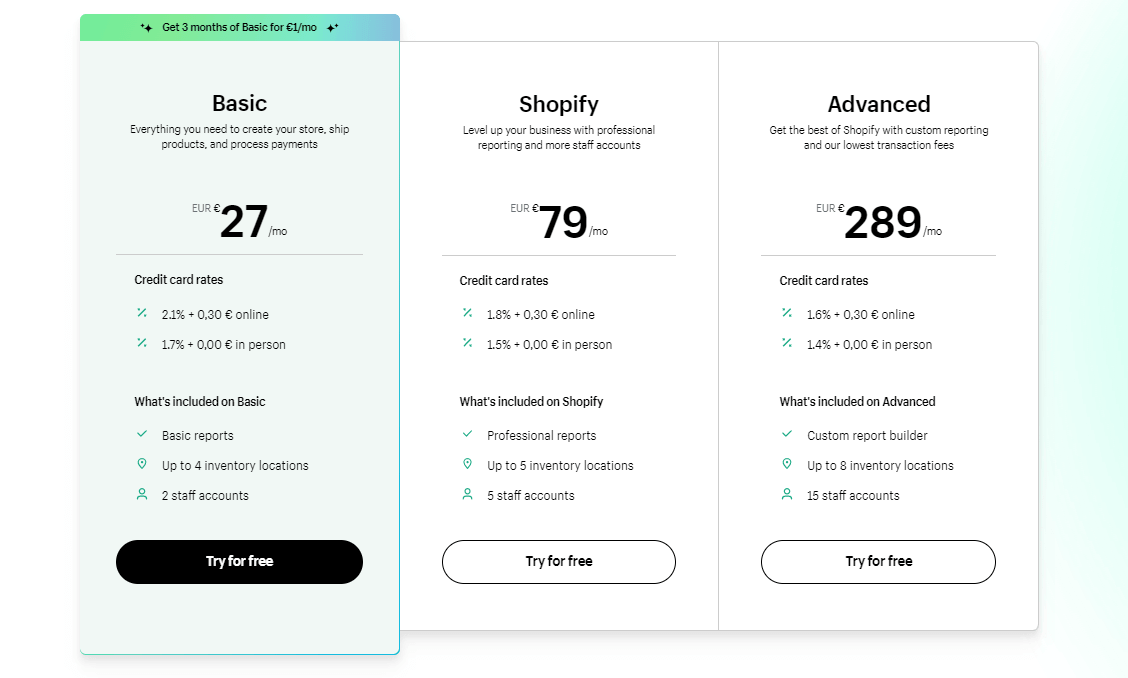
Shopify Plus vs Magento Enterprise (Adobe Commerce)
Shopify Plus and Adobe Commerce are both advanced versions of platforms, which require you to pay more for larger capabilities. However, if you are planning to run a big online store, those two are the right options for you.
The Shopify Plus plan starts at $2,000 per month, which includes standard setups and integrations. For a more complex business operation setup, you need to contact Shopify to get price quotes.
Adobe Commerce license pricing starts at $22,000 per year. With all operating costs, the price can reach $125,000.
Core Functionality
Anyone who once had a chance to test each platform’s admin panel will tell you that Magento has richer core functionality than Shopify.
Magento’s core functionality is tailored for retail and wholesale businesses that have complex requirements for product management. Among Magento 2 strengths, we can name promotions, customer segmentation, merchandising, and attribute management. Moreover, Magento 2 doesn’t limit the number of your staff accounts.
Let’s pay attention to Adobe Commerce. On top of mentioned above benefits of the platform (B2B, B2C, 24/7 support, omnichannel), it provides businesses with the options to host multiple websites and brands in different geographies, scale websites up with a cloud-based solution, as well as top level of security, extension customization, and powerful marketing functionality (customer segmentation and personalization).
Adobe Commerce users also have a choice between the on-premises deployment and a cloud-hosted solution. Adobe Cloud benefits are:
✔ Cloud availability SLA up to 99.99%;
✔ Fast page loading with a content delivery network (CDN);
✔ Performance monitoring tools;
✔ Enhanced security with Fastly WAF and DDOS services;
✔ PCI compliance;
✔ Easy deployment;
✔ Streamlined updates and testing.
Shopify also provides customer management, discounts, and collections, but its core functions are designed for smaller businesses selling simple products. And it limits the number of your staff accounts if you’re using basic Shopify subscriptions.
That’s why it’s fair to say that Magento’s core functionality is much stronger out of the box than the Shopify one.
In terms of products, Shopify has two types: simple and configurable products, which are enough for such businesses as art stores or fashion retailers. The number of product configurations in Shopify is limited, so you can choose either the color or size of a product and that will be it.
Magento Open Source edition provides six types of products: simple products, configurable products, grouped products, bundle products, downloadable, and virtual products. Meanwhile, Adobe Commerce features gift cards and a wider variety of products, giving more freedom in customization according to your business needs.
Multi-Store Management
Multi-store management is Magento’s key selling point compared to other platforms. We’re talking about different online storefronts, with various suppliers, different warehouses, different products — not just multiple domains on one store.
At its core, Magento 2 includes multi-source inventory functionality capable of juggling multiple lists of products and brands in various countries simultaneously, recalculating stock and sending you notifications, when you are running out of products, choosing the closest warehouse location to your customers, and much more. Moreover, you can upload your product list just once and configure each product with different attributes, pricing, and more for other countries.
Shopify platform is not designed to manage multi-stores or multi-brands in one single interface. To set it up, you will need to buy a new separate account and all the Shopify apps again and double all the settings and product attributes manually from scratch. Shopify’s platform implies different product lists for each store. Even with the Shopify Plus edition, you’ll have to create ‘clones’ of your store and manage each of them manually.
Usability
An easy-to-use platform makes your work fast, intuitive, and pleasant. And Shopify’s content management system is known for its comprehensive design.
Magento is not precisely an easy platform to use and is more suitable for medium or large businesses. To use Magento, you need technical knowledge and timely developer support. The platform requires restyling of the design and time to set up or launch.
Shopify is the easiest way to get your website up since it was designed as a ready-to-use platform. You can register on the platform, fill out the information about your company, products, administrative and organizational sections. Inventory management, promo campaigns, site redesign, and other changes on your website are just the matter of drag and drop.
Payment Gateways
The more built-in payment gateways, the more flexibility you offer to your clients. On the one hand, it may seem that Shopify beats Magento here. It comes with 70 payment gateways out of the box and has its own payment gateways built-in. On the other hand, Shopify charges from 1.5% to 2% of each transaction on your store depending on your Shopify plan when your clients use external payment gateways.
At the same time, Magento has three payment gateways out of the box – Paypal, Braintree, and Authorize.Net. If you would like to add more payment options, you can find extensions for that on the Magento marketplace. And you don’t need to pay a transaction fee. Another benefit of Magento payment options is that they support a massive variety of languages, making your store suitable for clients from different countries.
Shopify Payments is a free and easy-to-use processor. Also, you can use more than 100 payment gateways to choose from, given that you will need to pay a transaction fee.

Themes, Integrations, Extensions, and Apps
That is a tie for both Magento and Shopify as both have a well-developed marketplace with hundreds of themes and templates, extensions, and apps, either free or paid.
More than 3500 extensions for Magento and apps for Shopify cover all kinds of ecommerce purposes: SEO, marketing, blogs, integration with 3rd-party ERP, shipping and payment systems, etc. Yet, Shopify premium themes are more expensive than those of Magento: themes’ and templates’ prices for the former range from $16 to $900, while for the latter vary from $17 to $300. We would not recommend using free themes on both platforms as they are not verified and may not be compatible with your store nor meet all the requirements above.
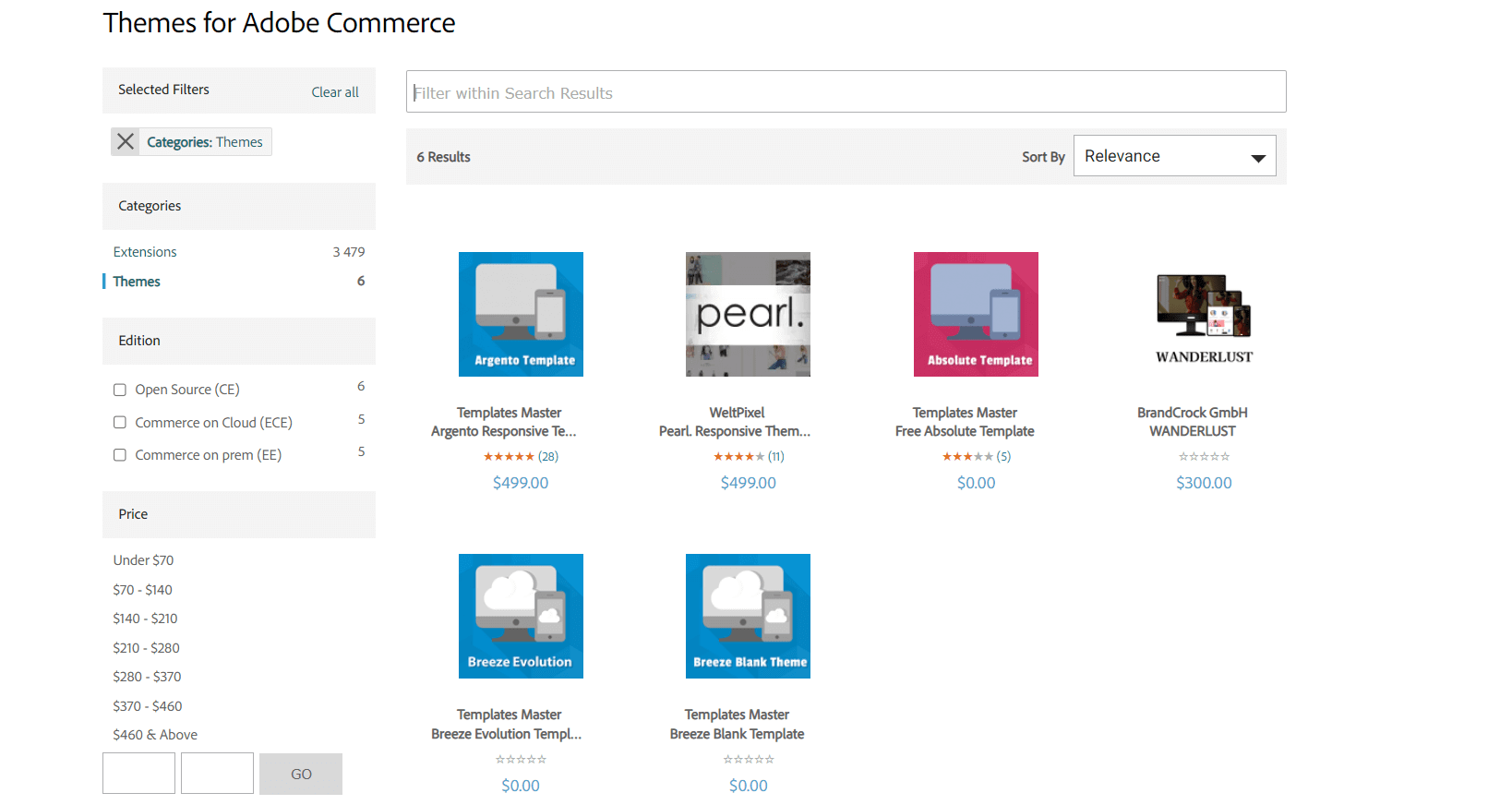
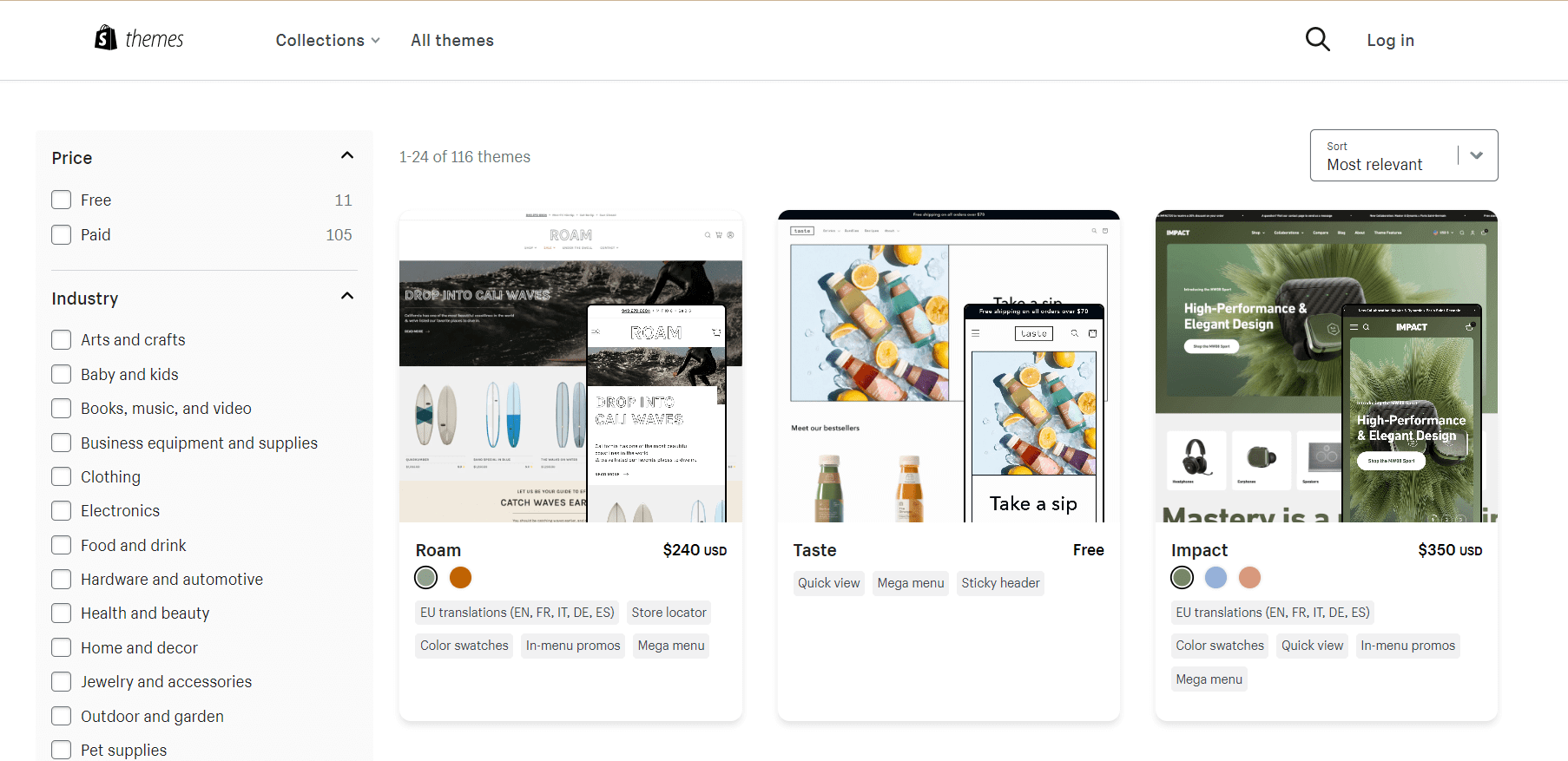
While choosing themes, please pay attention to their reviews, functionality, SEO, mobile-friendliness, and suitability to your store’s structure.
Here we need to mention that Shopify themes are proprietary and do not allow much customization. Magento themes are as responsive as playdough, allowing you to sculpt your own brand visual identity.
Extensions and apps are effortless to install and user-friendly. The only significant difference between them is that most Magento extensions have an annual billing cycle, and most Shopify apps have monthly billing cycles.
Marketing & Sales Tools
Magento inventory system works with built-in features such as importing products from a database, reporting total revenue, and real visitors. To integrate your store with Facebook, Instagram, or eBay, you need to install a respective extension. There is also an abandoned cart function, checkout settings, discounts, percentages, or fixed price.
Shopify’s electronic platform has many built-in functions that allow you to sell and select products and get paid for them. It also offers the ability to advertise and sell through multichannel channels such as Amazon, Facebook, or Instagram. Its “abandoned cart” feature will send automated emails to customers who left your site before completing a purchase. Also, Shopify works with major shipping companies such as DHL Express, UPS, or Canada Post.
SEO Tools
In the battle of Magento 2 vs Shopify, the former wins in terms of SEO. Shopify has several default tools and even more SEO apps, but all of them are limited because Shopify is a hosted platform. So, if you need to edit your URLs structure and hierarchy or configure server settings, you’d better go for Magento 2.
Magento comes with the following built-in SEO features:
✔ Direct access to robots.txt, sitemap.xml, CSS files;
✔ Creation of images sitemap.xml;
✔ SEO-friendly URLs;
✔ Editing meta tags: title, description, alt;
✔ Canonical tags;
✔ Schema.org in the default template;
✔ Product labels;
✔ Internal linking between products.
And what’s more – Magento offers accelerated loading speed thanks to Ajax add-to-cart, minimized JS, Varnish cache, and PHP7 support.
Shopify offers the following built-in SEO features:
✔ Editing meta titles and descriptions;
✔ Headings;
✔ Images alt;
✔ Creating custom URL names;
✔ Setting 301 redirects and canonicals;
✔ Adding Google Analytics code.
Shopify also features a wide variety of SEO apps, good speed, and uptime.
On the other hand, Shopify does not have access to robots.txt or sitemap.xml files and has no access to CSS files, which are SEO basics. The files are generated automatically by Shopify.
Every site owner uses Google PageSpeed Insights to optimize their site’s loading speed on desktop and mobile devices, which is impossible without root access to CSS files on the server. Strings in URLs: Shopify automatically adds an extra line to your pages’ URLs, such as /product/, /pages/, /blog/, /collections/, which means a different nesting level and poorer accessibility for search crawlers.
There are no subcategories out of the box – they are named “subcollections” and require coding to be created. So, for example, you can organize your blog posts using tags only.
Non-ecommerce content, such as pages and blog posts, does not adapt automatically if you switch to another theme.
There are no social sharing buttons out of the box. If you want your content to be shared across social media, you’ll need to find a Shopify theme providing social sharing buttons or go for an app.
Support & Community
Magento comes with only developer support. There is no free 24/7 phone support, but you can purchase the support hours of a Magento Technical Account Manager.
The saving grace is that Magento has a vast community of Magento partners and specialists who share their experience on Magento forums, Github, and Slack channels. So, in case any question arises, you will always be able to find a person who already faced it, solved it, and documented the process.
Shopify, at another point, offers 24/7 support for all of their pricing plans. Merchants can quickly submit their requests on a separate portal and get help.
Aside from official support, there is a second option – asking the community in person. Both platforms have hundreds of top-level developers who are not only creating thousands of online stores, apps, and extensions but are always glad to share their valuable insights on annual ecommerce conferences that stretch the globe.
Shopify vs Magento: Works for Who
All these comparison charts and detailed functionality lists may seem confusing while choosing a platform for your business. So, to be short, answer three simple questions:
🟠Do your products have more than two attributes?
🟠Do you have more than three stores?
🟠Does your product list exceed 400 SKUs?
If yes, Magento is your choice. If no – Shopify is. It’s that simple 🙂
If you want to see some real examples of online shops in action, here are some fantastic Shopify stores and Magento website examples.
Conclusion
In conclusion, there is a huge variety of e-commerce platforms, like BigCommerce, WooCommerce, Shopware, on the market right now, which all have many pros and cons.
To understand what works best for you, you need to analyze and carefully study the ins and outs of your business. If you are still in doubt and cannot decide, contact us, and we will help you make the right choice, even if it is not Magento or Shopify, after all.




